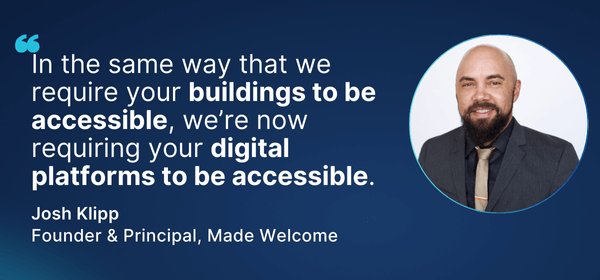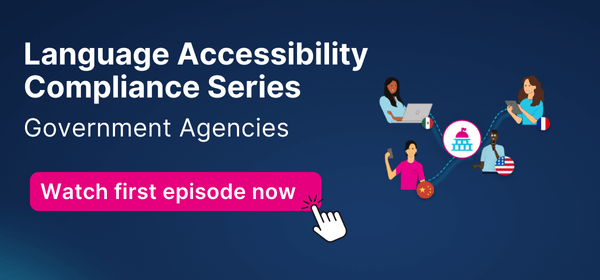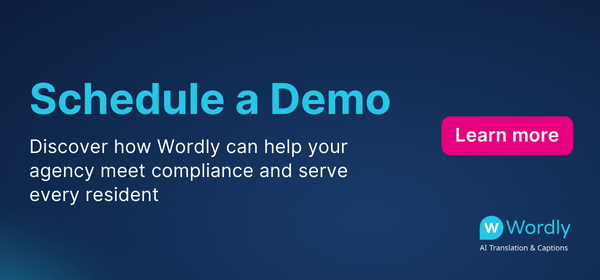Wordly launches Voice Transcripts for AI Dubbing — Learn More
Language access is no longer optional for government agencies – it’s a legal requirement, a public service imperative, and increasingly, a strategic advantage. In this post, we’ll break down key compliance issues, highlight the latest rulings, and show how technology like AI translation and captioning can help agencies stay compliant while better serving their communities.
Language access ensures that people who are Hard of Hearing or have Limited English Proficiency (LEP) can engage fully with public services. Without it, entire communities are excluded from decision-making and vital resources.
For government agencies, language access often means providing real-time captions during public meetings, translating notices and forms, and making digital platforms multilingual. Done well, it not only satisfies compliance but also strengthens trust and participation across diverse communities.
The Department of Justice (DOJ) Final Ruling makes digital accessibility a binding requirement. Agencies must now ensure public-facing content meets WCAG 2.1 Level AA standards. This includes:
The ruling underscores that accessibility isn’t just best practice, it’s mandatory.

The revocation of Executive Order 13166 and replacement with Executive Order 14224 has left some agencies uncertain. The bottom line: Title VI of the Civil Rights Act remains in full force. Any agency receiving federal funding is still required to provide meaningful language access. The shift in executive orders doesn’t eliminate the obligation; it simply reframes federal oversight.
Agencies that fall behind risk civil rights complaints, penalties, and loss of funding.
One of the most effective ways to help meet accessibility standards is by integrating real-time translation and captioning into digital platforms. This helps make content more accessible for Deaf, Hard of Hearing, and non-native English speakers.
Thanks to AI captioning from Wordly, agencies can scale this across departments and events without the high costs or logistical challenges of human captioners.
When public meetings are live streamed or recorded, accessibility is not optional. Agencies must:
Failing to meet these standards risks excluding citizens from civic participation and exposes agencies to legal challenges.

Budget constraints are one of the biggest hurdles to comprehensive language access. Traditional captioning and interpretation services are expensive and often limited in reach.
AI-powered government translation and captioning address these challenges by:
This makes it possible for governments to expand access without overwhelming resources.
Compliance is the starting point, but agencies that prioritize language access gain more than legal coverage. They build stronger community trust, improve civic engagement, and reinforce their reputation as inclusive, forward-looking institutions.
In short, language access turns into a strategic advantage, not just a compliance checkbox.
Language access requirements extend beyond U.S. regulations.
What is the DOJ Final Ruling?
The Department of Justice’s Final Ruling establishes binding requirements for digital accessibility, mandating that public-facing content meets WCAG 2.1 Level AA standards.
How does the DOJ Final Ruling impact local government agencies?
Agencies must provide accessible websites, live streams, videos, and documents. This includes real-time captioning and translated content to serve all residents equally.
What are government agency obligations under Title VI of the Civil Rights Act?
Title VI requires agencies receiving federal funds to provide meaningful access to LEP individuals. This obligation remains in place regardless of executive order changes.
How can government agencies use real-time captioning to meet WCAG 2.1 Level AA standards?
By embedding AI-powered captioning into live streams, meetings, and recorded videos, agencies ensure content is both compliant and accessible.
How can government agencies ensure digital content is accessible to all citizens?
Agencies should combine real-time captioning, translated transcripts, and accessible document formats to meet ADA and WCAG standards.
How can AI translation and captioning enable agencies to expand language access?
AI reduces costs and logistical barriers, delivering real-time multilingual access at scale — something human interpreters alone can’t achieve.
How can language access be a strategic advantage for local and state governments?
Beyond compliance, language access builds trust, strengthens civic engagement, and enhances an agency’s reputation as inclusive and community-focused.
How does Quebec's Bill 96 impact government entities and public services?
Bill 96 prioritizes French in all public communication, requiring agencies in Quebec to adjust operations while still supporting multilingual populations.
How can AI translation and captioning tools assist with the new EAA rules?
The European Accessibility Act (EAA) requires accessible digital services across the EU. AI captioning and translation help governments meet these standards by ensuring content is both multilingual and accessible.

Government agencies face mounting compliance demands – from DOJ rulings to Title VI obligations and international regulations. The good news is that modern AI translation and captioning tools like Wordly make it possible to meet some of these standards cost-effectively while also strengthening public engagement.
Language access isn’t just about avoiding penalties. It’s about creating inclusive communities where every resident can stay informed, engaged, and connected.
Schedule a personalized demo to see how AI-powered government translation and real time captioning can help your agency stay compliant and better serve every resident.
Disclaimer: Content provided is for informational purposes and does not constitute legal advice. Agencies should consult their legal advisors regarding compliance obligations.
